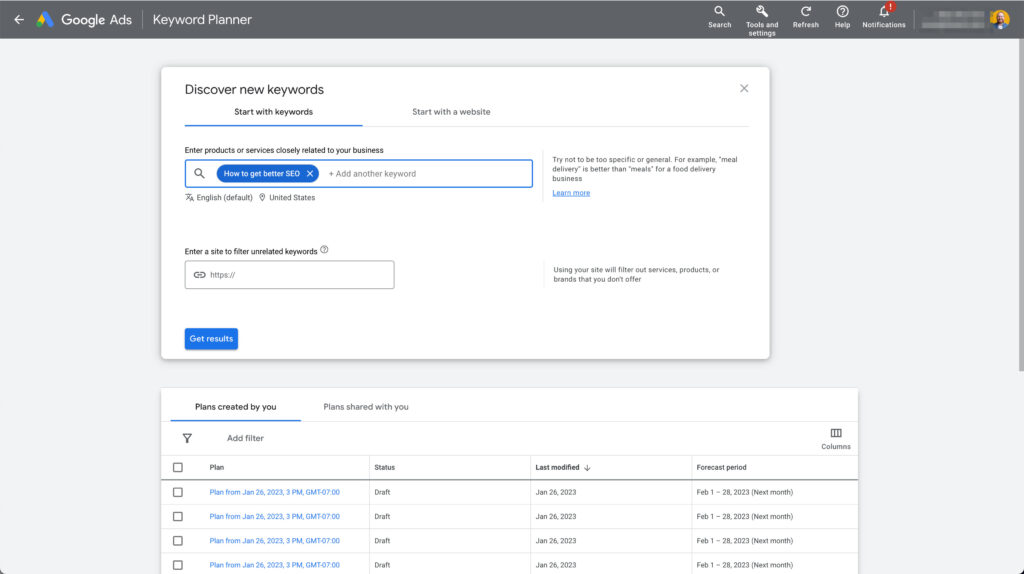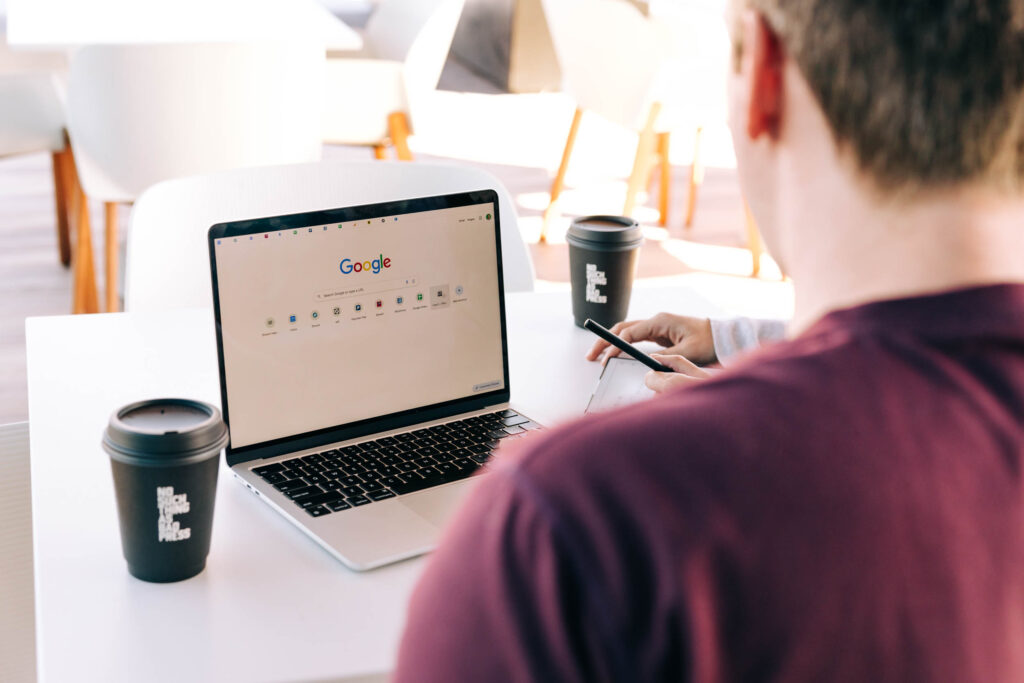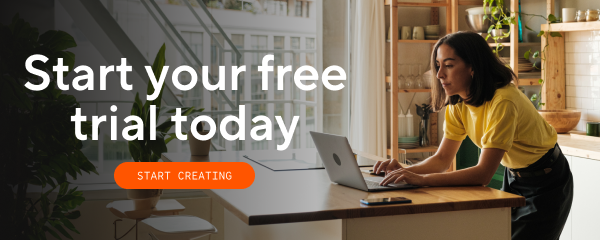People decide whether to keep reading your website or blog post in about 3 seconds.
And that decision is based almost entirely on your headline.
After helping thousands of creative entrepreneurs build successful websites, we've seen firsthand that your headline is the most valuable real estate on your entire site.
You know it’s true, too. You’ve probably been guilty of X-ing out or not clicking on something that doesn’t instantly grab your attention.
What's the point of spending hours creating incredible website content if your headline doesn't convince anyone to actually read it?
The headline is where the battle for attention is won or lost.
But here's where things get tricky…
Sometimes the headlines that perform best for SEO aren't the same ones that get the most clicks or conversions. And the super-catchy, click-worthy headlines? They might not help your SEO one bit.
So what's a business owner to do?! Let's dive into exactly how to create headlines that serve BOTH masters – search engines AND human readers.
The Great Headline Balancing Act: SEO vs. Conversion
There's often a tug-of-war when crafting headlines:
SEO-optimized headlines focus on:
- Including exact-match keywords
- Being descriptive of the content
- Being specific and clear
- Following a standard structure
Conversion-focused headlines prioritize:
- Emotional impact
- Curiosity
- Benefits to the reader
- Personality and brand voice
GOOD THING you don't have to choose just one approach! The best headlines actually blend both strategies.
But before we get into exactly how to do that, let's take a step back and consider…
Know Your Goal Before Writing a Single Headline
Different pages on your website serve different purposes, and their headlines should reflect that:
Homepage Headlines
The primary headline on your homepage isn't typically trying to rank for a specific keyword. Instead, it should:
- Clearly communicate what you do
- Speak directly to your ideal client's desires or pain points
- Differentiate you from competitors
- Set the tone for your brand voice
For example, rather than “Professional Photography Services in Denver” (yawn), you might use “Capture Your Family's Most Magical Moments Before They're Gone” (emotional connection) or “Denver's Most Sought-After Family Photographer for Busy Parents” (clear value proposition).
Service Page Headlines
Service page headlines need to balance SEO with clarity about your offerings. They should:
- Include your primary service keyword
- Communicate the unique value your service provides
- Be specific about who the service is for
- Highlight what makes your approach different
Instead of “Website Design Services” (too generic), try “Custom Showit Website Design for Photographers Who Want to Book More Clients” (specific audience, clear benefit, includes keywords).
Blog Post Headlines
Blog headlines often have the most flexibility and can lean more heavily into curiosity and emotion while still incorporating keywords. Great blog headlines:
- Target a specific keyword or question
- Promise a clear benefit or solution to a problem
- Create curiosity or emotional response
- Set clear expectations about the content format (list, guide, case study, etc.)
Rather than “How to Take Better Photos” (too broad), you could use “7 Composition Techniques That Will Instantly Improve Your Photography” (specific, actionable, implies quick results).
About Page Headlines
About page headlines should focus more on connection than SEO, as they're rarely a primary landing page from search. Effective About page headlines:
- Create an emotional connection
- Hint at your story or journey
- Reflect your personality
- Bridge the gap between you and your ideal clients
Instead of “About Our Company” (please never use this!), try “From Kitchen Table Side-Hustle to Award-Winning Design Studio: Our Journey” or “We Help Heart-Centered Entrepreneurs Build Websites That Feel Like Home.”
How to Write Headlines That Satisfy BOTH SEO and Readers
Now for the magic formula that helps you create headlines that rank AND convert:
Step 1: Start with Keyword Research

Before writing any headline, know what terms people are actually searching for. Use tools like:
- Google Keyword Planner
- Ubersuggest
- Answerthepublic.com
- Even Google's autocomplete suggestions
Look for keywords that have:
- Decent search volume
- Manageable competition
- Clear search intent that matches your content
Step 2: Understand Search Intent

Google has gotten scary-good at understanding what people actually want when they search for something. Your headline needs to match that intent:
Informational intent (looking for answers): “How to Choose the Perfect Wedding Photographer for Your Style”
Navigational intent (looking for a specific site/brand): “Showit Website Templates: The Complete Collection for 2023”
Commercial intent (researching before buying): “Showit vs. Squarespace: Which Platform Is Right for Photographers?”
Transactional intent (ready to buy): “Book Your Custom Showit Website Design: Packages & Process”
Step 3: Craft the SEO-Friendly Base Version
Create a clear, specific headline that includes your target keyword in a natural way. This becomes your foundation.
For example: “How to Write Email Newsletters That Subscribers Actually Open”
Step 4: Add Emotional Triggers or Curiosity Elements
Now enhance your headline with elements that trigger emotional responses:
- Numbers: “17 Email Subject Lines That Doubled Our Open Rates”
- Power words: “Irresistible,” “Essential,” “Proven,” “Unexpected”
- Curiosity gaps: “The Counterintuitive Reason Your Newsletters Are Being Ignored”
- Specificity: “How I Grew My Email Open Rates from 22% to 67% in 30 Days”
- Personal pronouns: “Why Your Subscribers Are Ignoring Your Newsletters”
So our example might become: “How to Write Irresistible Email Newsletters Your Subscribers Will Actually Open (Even if You're Not a Writer)”
Step 5: Optimize Length for Different Platforms
Different platforms have different ideal headline lengths:
- Website pages: Keep it under 60 characters so it doesn't get cut off in search results
- Blog posts: Can be longer, but aim for 50-70 characters for SEO titles
- Email subject lines: 30-50 characters perform best
- Social media: Varies by platform (Twitter/X: 55-70 characters, Facebook: 40-80 characters)
If your headline is too long for SEO purposes, create a shorter version specifically for your meta title tag while keeping the longer, more conversational version on the actual page.
6 Headline Formulas That Always Deliver
When you're stuck (or just need to write something quickly), these proven formulas can help you create headlines that work:
1. The “How-To” Headline
Formula: How to [Achieve Desired Outcome] Without [Pain Point] Examples:
- “How to Build a Beautiful Website Without Hiring a Designer”
- “How to Book High-Paying Clients Without Working More Hours”
2. The List Headline
Formula: [Number] [Desirable Things] That Will [Positive Outcome] Examples:
- “7 Website Tweaks That Will Double Your Inquiry Rate This Month”
- “21 Photography Poses That Will Make Anyone Look Like a Model”
3. The Question Headline
Formula: Is Your [Thing] [Negative Situation]? Here's How to Fix It Examples:
- “Is Your About Page Secretly Driving Clients Away? Here's How to Fix It”
- “Are You Making These 5 Fatal Email Marketing Mistakes?”
4. The Secret-Revealing Headline
Formula: The Secret to [Achieving Desired Outcome] Examples:
- “The Secret to Writing Website Copy Clients Can't Resist”
- “The Little-Known Formula Behind Every Successful Wedding Photography Business”
5. The “What Everybody Ought to Know” Headline
Formula: What Every [Type of Person] Ought to Know About [Topic] Examples:
- “What Every Photographer Ought to Know About Website Conversion”
- “What Every Small Business Owner Needs to Know About Email Marketing”
6. The Case Study Headline
Formula: How [Person/Brand] [Achieved Result] in [Timeframe] Examples:
- “How This Wedding Photographer Booked 35 Weddings in 30 Days With One Email”
- “How I Doubled My Website Conversion Rate By Changing Just 3 Things”
A/B Testing: The Secret Weapon of Headline Masters
Want to know what the real pros do when they can't decide between two headline options?
They don't choose. They test both.
A/B testing your headlines is the single most effective way to improve your conversion rates over time. You can test headlines for:
- Email subject lines
- Blog post titles (using social media to test variations)
- Landing page headlines
- Call-to-action buttons
When testing headlines, only change ONE element at a time:
- Test numbers against each other (7 vs. 21 tips)
- Test different power words (“Essential” vs. “Critical”)
- Test question headlines against statement headlines
- Test including vs. excluding your target keyword
Many email platforms have built-in A/B testing. For website pages, you can use tools like Google Optimize or Hotjar to test headline variations.
Headlines That Google Loves (But People Might Scroll Past)
There's a certain type of headline that performs really well in search results but might not grab attention in other contexts:
The ultra-specific, comprehensive guide headline: “The Complete Step-by-Step Guide to Creating a Content Calendar for Your Photography Business (With Templates)”
These headlines:
- Are very long and detailed
- Include exact-match keywords
- Often contain parenthetical additions
- Sound more like academic paper titles than marketing
While they might not win creativity awards, they often rank extremely well because they very clearly tell Google exactly what the content is about.
For blog posts in particular, you might want to use a more SEO-friendly headline in your meta title tag (what shows up in search results) and a more compelling, curiosity-driven headline on the actual page.
Headlines That People Love (But Google Might Ignore)
On the flip side, some of the most clickable headlines don't help your SEO at all:
The pure curiosity headline: “I Tried This Weird Trick on My Website and You Won't Believe What Happened Next”
These headlines:
- Create intense curiosity
- Often use vague language
- May include personal pronouns
- Don't typically include keywords
- Can sometimes feel clickbaity
These perform extremely well on social media or in emails where the context is already established, but they provide very little information to search engines about your content.
The Headline Secret Nobody Talks About: It's Not Just the Words
Here's something that doesn't get discussed enough: the visual presentation of your headline matters almost as much as the words themselves.
On your website, consider:
Font Choice
Your headline font should be:
- Easily readable (priority #1)
- Reflective of your brand personality
- Appropriately sized (typically 2-3x larger than body text)
- High contrast against the background
Headlines should be:
Headlines should be:
- Above the fold whenever possible
- Aligned with accompanying visuals
- Properly spaced (with room to breathe)
- Consistent across similar pages
Supporting Elements
Consider adding:
- A small subheadline that expands on your main headline
- Visual cues that draw attention to the headline (arrows, underlines, etc.)
- A high-quality image that reinforces the headline message
- Design elements that frame the headline
With Showit's design flexibility, you can create visually stunning headlines that grab attention through both words AND design elements! Our drag-and-drop editor makes it easy to experiment with different headline presentations until you find the perfect combination for your brand.
Want To See Great Headlines In Action? Stalk These Before & After Examples
Nothing illustrates the power of great headlines like seeing real transformations. Here are some actual before-and-after examples that show the difference between a meh headline and a money-making headline.
Website Homepage:
BEFORE: “Jane Smith Photography” (Generic, says nothing about value or differentiation)
AFTER: “Capturing Your Family's Authentic Joy in Portland's Natural Landscapes” (Clear specialization, location, and emotional benefit)
Service Page:
BEFORE: “Website Design Services” (Generic, highly competitive, no unique value)
AFTER: “Custom Showit Websites for Photographers Who Want to Stand Out & Book More Clients” (Specific platform, target audience, and clear benefits)
Blog Post:
BEFORE: “Email Marketing Tips” (Too broad, competitive, and doesn't promise specific value)
AFTER: “7 Email Templates That Convert Inquiries to Clients (Copy, Paste & Customize)” (Specific number, clear benefit, actionable promise)
About Page:
BEFORE: “About Me” (Please never use this on your website!)
AFTER: “From Corporate Burnout to Booked-Out Designer: How Helping One Friend Led to My Dream Business” (Tells a story, creates intrigue, shows transformation)
When to Write Your Headlines (Hint: Not When You Think)
Most people write their headlines first. But here's a pro tip from our experience working with thousands of successful websites:
Try this approach instead:
- Write your content first
- Draft 10-15 possible headlines
- Let them sit overnight if possible
- Come back and choose the strongest options
- Test the best 2-3 versions if possible
By writing your content first, you'll have a much clearer understanding of:
- The specific value your content delivers
- The main points and takeaways
- The tone and voice of the piece
- The keywords that naturally emerge
This approach often leads to more authentic, accurate headlines that truly reflect what makes your content valuable.
Headlines Your Competition Isn't Using (But Should Be)
Want to stand out from all the generic headlines in your industry? We've seen these less common approaches work wonders for our Showit users:
The Contrarian Headline
Challenge conventional wisdom in your field:
- “Why Most Photography Pricing Advice Is Actually Hurting Your Business”
- “The Popular Website ‘Rule' That's Actually Driving Away Your Visitors”
The Specificity Headline
Get ultra-specific about results or methods:
- “How This 15-Minute Homepage Tweak Increased Inquiries by 317% in Just One Week”
- “The Exact 5-Email Sequence That Converted 82% of My Consult Calls Into Clients”
The Personal Story Headline
Use your own experience to create a connection:
- “How I Went From Zero Bookings to Waitlist in 90 Days (Without Paid Ads)”
- “I Almost Quit My Business Last Year—Here's What Saved It”
The “What Nobody Tells You” Headline
Reveal insider information:
- “What Nobody Tells You About Running a Photography Business (Until It's Too Late)”
- “The Hidden Costs of DIY Websites: What Template Sellers Don't Want You to Know”
The Future-Prediction Headline
Position yourself as a trendsetter:
- “5 Website Trends That Will Dominate 2024 (And 3 That Will Vanish)”
- “Why Voice Search Will Change Everything About SEO (And How to Prepare Now)”
Headlines That Convert on Your Showit Website
As you're crafting headlines for your Showit website, remember that conversion happens when the right message meets the right audience at the right time.
Your headlines should:
- Speak directly to your ideal client's current situation
- Address their deepest desires or most pressing pain points
- Differentiate you from competitors they've already seen
- Promise a specific, valuable outcome
One thing we love about Showit is how easy it makes creating visually stunning headlines. You're not limited to basic text formatting – you can add design elements, animations, and perfect spacing to make your headlines truly pop.
We see it all the time with our users – when they combine powerful headline copy with Showit's design capabilities, their conversion rates skyrocket!
Headline Mistakes We See All The Time (Even From Pros)
After helping thousands of creative entrepreneurs build their websites, we've spotted some common headline mistakes that even experienced business owners make:
1. Being Too Clever
Sometimes headlines try so hard to be clever that they sacrifice clarity. Remember: if your reader doesn't immediately understand what you're offering, they'll move on.
2. Forgetting the Benefit
Your headline should answer the eternal question in your reader's mind: “What's in it for me?” Leading with features instead of benefits is a missed opportunity.
3. Writing for Everyone
The most powerful headlines speak directly to a specific audience. When you try to appeal to everyone, you often end up resonating with no one.
4. Ignoring Mobile Users
With more than half of web traffic coming from mobile devices, your headlines need to be concise enough to display properly on smaller screens.
5. The Bait-and-Switch
Your headline creates a promise that your content needs to fulfill. If there's a disconnect between what the headline promises and what the content delivers, you'll lose trust.
6. Headline Neglect
Many website owners spend hours on their content but only seconds on their headlines. Given the importance of headlines in getting people to actually read your content, this approach is backward!
7. Feature-Focused Headlines
“Professional Photography Services” focuses on what you do. “Preserving Your Family's Most Precious Moments” focuses on what your client gets. Always choose the latter.
Headlines That Work Across Different Industries
We've worked with thousands of creative entrepreneurs across countless industries, and we've seen what works. Here are some industry-specific headline examples that have driven real results:
For Photographers:
- “Capturing the Moments You Never Want to Forget (In a Way That's Actually Fun)”
- “Wedding Photography for Couples Who Want Art, Not Just Photos”
- “Family Sessions That Capture Your Kids Being Kids (Not Just Smiling at the Camera)”
For Coaches/Consultants:
- “Stop Hustling for Clients: The 3-Step Framework for Predictable $10K Months”
- “Business Strategy for Creative Entrepreneurs Who Hate ‘Business Strategy'”
- “From Overwhelmed to Organized: How to Finally Build Systems That Scale Your Business”
For Designers:
- “Custom Brand Design That Attracts Premium Clients (Even in a Crowded Market)”
- “Websites That Work as Hard as You Do: Design That Converts Visitors to Clients”
- “Strategic Design for Entrepreneurs Who Know Pretty Isn't Enough”
For Service Providers:
- “Virtual Assistant Services That Give You Back 20+ Hours Every Week”
- “Bookkeeping for Creative Entrepreneurs Who'd Rather Create Than Crunch Numbers”
- “SEO Services That Actually Lead to Client Inquiries (Not Just ‘Traffic')”
Start Crafting Better Headlines Today
Great headlines aren't born—they're made through practice, testing, and constant refinement.
Here's your action plan:
- Audit your current website headlines using the principles in this post
- Identify the 3 most important pages to optimize first
- Draft at least 5-10 alternative headlines for each
- Get feedback from people in your target audience
- Implement the strongest options
- Track changes in traffic, engagement, and conversion
Remember, your headline is a promise to your reader about the value they'll receive from your content. Make it compelling, make it clear, and above all, make sure you deliver on that promise!
The great thing about using Showit for your website is that you can update your headlines anytime, without needing a developer.
See a headline that's not performing? Just hop into our drag-and-drop editor and change it in seconds!
Ready to create a website with headlines that convert browsers into buyers? Try Showit free for 14 days and see why creative entrepreneurs love our platform!=


